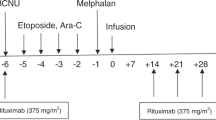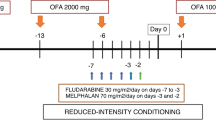Abstract
High-dose melphalan has been the standard conditioning regimen for auto-SCT in multiple myeloma (MM) for decades. A more effective conditioning regimen may induce deeper responses and longer remission duration. It is especially needed in the setting of second auto-SCT, which rarely achieves comparable results with the first auto-SCT using the same conditioning regimen. Here we conducted a phase II study to investigate the efficacy and safety of a conditioning regimen V-BEAM (bortezomib-BEAM) before second auto-SCT for multiple myeloma. Ten patients were enrolled from September 2012 to May 2013. The CR rate at day +100 after auto-SCT was 75%; all except for one patient remained in remission after a median follow-up of 6 months. Three patients developed Clostridium difficile infection. Two patients died within the first 30 days of auto-SCT from neutropenic colitis and overwhelming sepsis, respectively. Due to the high rate of morbidity and mortality, the study was terminated after 10 patients. In summary, although the conditioning regimen V-BEAM before second auto-SCT for MM provided promising responses, it was associated with unexpected treatment-related toxicity and should not be investigated further without modifications.
This is a preview of subscription content, access via your institution
Access options
Subscribe to this journal
Receive 12 print issues and online access
$259.00 per year
only $21.58 per issue
Buy this article
- Purchase on Springer Link
- Instant access to full article PDF
Prices may be subject to local taxes which are calculated during checkout
Similar content being viewed by others
References
Siegel R, Naishadham D, Jemal A . Cancer statistics, 2013. CA Cancer J Clin 2013; 63: 11–30.
Attal M, Harousseau JL, Stoppa AM, Sotto JJ, Fuzibet JG, Rossi JF et al. A prospective, randomized trial of autologous bone marrow transplantation and chemotherapy in multiple myeloma. Intergroupe Francais du Myelome. New Engl J Medi 1996; 335: 91–97.
Attal M, Lauwers-Cances V, Marit G, Caillot D, Moreau P, Facon T et al. Lenalidomide maintenance after stem-cell transplantation for multiple myeloma. New Engl J Med 2012; 366: 1782–1791.
McCarthy PL, Owzar K, Hofmeister CC, Hurd DD, Hassoun H, Richardson PG et al. Lenalidomide after stem-cell transplantation for multiple myeloma. New Engl J Med 2012; 366: 1770–1781.
Blimark C, Veskovski L, Westin J, Rodjer S, Brune M, Hjorth M et al. Melphalan 100 mg/m2 with stem cell support as first relapse treatment is safe and effective for myeloma patients with long remission after autologous stem cell transplantation. Eur J Haematol 2011; 87: 117–122.
Shah N, Ahmed F, Bashir Q, Qureshi S, Dinh Y, Rondon G et al. Durable remission with salvage second autotransplants in patients with multiple myeloma. Cancer 2012; 118: 3549–3555.
Jimenez-Zepeda VH, Mikhael J, Winter A, Franke N, Masih-Khan E, Trudel S et al. Second autologous stem cell transplantation as salvage therapy for multiple myeloma: impact on progression-free and overall survival. Biol Blood Marrow Ttransplant 2012; 18: 773–779.
Olin RL, Vogl DT, Porter DL, Luger SM, Schuster SJ, Tsai DE et al. Second auto-SCT is safe and effective salvage therapy for relapsed multiple myeloma. Bone Marrow Transplant 2009; 43: 417–422.
Sellner L, Heiss C, Benner A, Raab MS, Hillengass J, Hose D et al. Autologous retransplantation for patients with recurrent multiple myeloma: a single-center experience with 200 patients. Cancer 2013; 119: 2438–2446.
Lonial S . Relapsed multiple myeloma. Hematology/the Education Program of the American Society of Hematology. American Society of Hematology. Education Program 2010; 2010: 303–309.
Fenk R, Liese V, Neubauer F, Bruns I, Kondakci M, Balleisen S et al. Predictive factors for successful salvage high-dose therapy in patients with multiple myeloma relapsing after autologous blood stem cell transplantation. Leuk Lymphoma 2011; 52: 1455–1462.
Moreau P, Facon T, Attal M, Hulin C, Michallet M, Maloisel F et al. Comparison of 200 mg/m(2) melphalan and 8 Gy total body irradiation plus 140 mg/m(2) melphalan as conditioning regimens for peripheral blood stem cell transplantation in patients with newly diagnosed multiple myeloma: final analysis of the Intergroupe Francophone du Myelome 9502 randomized trial. Blood 2002; 99: 731–735.
Anagnostopoulos A, Aleman A, Ayers G, Donato M, Champlin R, Weber D et al. Comparison of high-dose melphalan with a more intensive regimen of thiotepa, busulfan, and cyclophosphamide for patients with multiple myeloma. Cancer 2004; 100: 2607–2612.
Benson DM Jr., Elder PJ, Lin TS, Blum W, Penza S, Avalos B et al. High-dose melphalan versus busulfan, cyclophosphamide, and etoposide as preparative regimens for autologous stem cell transplantation in patients with multiple myeloma. Leuk Res 2007; 31: 1069–1075.
Kazmi SM, Saliba RM, Donato M, Wang M, Hosing C, Qureshi S et al. Phase II trial of high-dose topotecan, melphalan and CY with autologous stem cell support for multiple myeloma. Bone Marrow Transplant 2011; 46: 510–515.
Roussel M, Moreau P, Huynh A, Mary JY, Danho C, Caillot D et al. Bortezomib and high-dose melphalan as conditioning regimen before autologous stem cell transplantation in patients with de novo multiple myeloma: a phase 2 study of the Intergroupe Francophone du Myelome (IFM). Blood 2010; 115: 32–37.
Lonial S, Kaufman J, Tighiouart M, Nooka A, Langston AA, Heffner LT et al. A phase I/II trial combining high-dose melphalan and autologous transplant with bortezomib for multiple myeloma: a dose- and schedule-finding study. Clin Cancer Res 2010; 16: 5079–5086.
Gimsing P, Hjertner O, Abildgaard N, Andersen NF, Dahl TG, Gregersen H et al. A phase II study of bortezomib-dexamethason followed by high-dose melphalan combined with bortezomib in patients relapsing after high-dose melphalan with autologous stem cell support. Blood 2011; 118: Abstract 3073.
Thompson PA, Prince HM, Seymour JF, Ritchie D, Stokes K, Burbury K et al. Bortezomib added to high-dose melphalan as pre-transplant conditioning is safe in patients with heavily pre-treated multiple myeloma. Bone Marrow Transplant 2011; 46: 764–765.
Carmustine package insert In: Bristol-Myers Squibb, 2011.
Gasparetto C, Bacon WA, Doan P, Rizzieri DA, Horwitz ME, Chute JP et al. High dose BCNU/melphalan preparative regimen doubles event free survival of myeloma patients undergoing autologous transplantation. Blood 2011; 118: Abstract 2012.
Chen AI, Negrin RS, McMillan A, Shizuru JA, Johnston LJ, Lowsky R et al. Tandem chemo-mobilization followed by high-dose melphalan and carmustine with single autologous hematopoietic cell transplantation for multiple myeloma. Bone Marrow Transplantation 2012; 47: 516–521.
Barlogie B, Velasquez WS, Alexanian R, Cabanillas F . Etoposide, dexamethasone, cytarabine, and cisplatin in vincristine, doxorubicin, and dexamethasone-refractory myeloma. J Clin Oncol 1989; 7: 1514–1517.
Munshi N, Desikan K, Jagannath S, Lonial S . Dexamethasone, cyclophosphamide, etoposide and cisplatinum (DCEP), an effective regimen for relapse after high-dose chemotherapy and autologous transplantation (AT). Blood 1996; 88: Abstract 586a.
Dadacaridou M, Papanicolaou X, Maltesas D, Megalakaki C, Patos P, Panteli K et al. Dexamethasone, cyclophosphamide, etoposide and cisplatin (DCEP) for relapsed or refractory multiple myeloma patients. J BUON 2007; 12: 41–44.
Durie BG, Harousseau JL, Miguel JS, Blade J, Barlogie B, Anderson K et al. International uniform response criteria for multiple myeloma. Leukemia 2006; 20: 1467–1473.
Kyle RA, Rajkumar SV . Criteria for diagnosis, staging, risk stratification and response assessment of multiple myeloma. Leukemia 2009; 23: 3–9.
Common Terminology Criteria for Adverse Events (CTCAE) Version 4.03. In: National Cancer Institute, 2010.
Atanackovic D, Schilling G . Second autologous transplant as salvage therapy in multiple myeloma. Br J Haematol 2013; 163: 565–572.
Hebraud B, Roussel M, Ysebaert L, Gaudin C, Laurent G, Attal M et al. Bortezomib and BEAM conditioning regimen for autologous stem cell transplantation in mantle cell lymphoma. Haematologica 2009; 94 (Suppl 2): 462 (abstract 1143).
Gil L, Poplawski D, Mol A, Nowicki A, Schneider A, Komarnicki M . Neutropenic enterocolitis after high-dose chemotherapy and autologous stem cell transplantation: incidence, risk factors, and outcome. Transpl Infect Dis 2013; 15: 1–7.
Coward JI, Ding NL, Feakins R, Kocher H, Popat S, Szlosarek PW . Chemotherapy-induced bowel obstruction in small cell lung cancer: a case report. Med Oncol 2012; 29: 2623–2625.
Perfetti V, Palladini G, Brunetti L, Sgarella A, Brugnatelli S, Gobbi PG et al. Bortezomib-induced paralytic ileus is a potential gastrointestinal side effect of this first-in-class anticancer proteasome inhibitor. Eur J Gastroenterol Hepatol 2007; 19: 599–601.
Waller JM, Moretto JC, Knopf KB . Multiple significant bortezomib-related toxicities in one patient: case report and literature review. Clin Lymphoma Myeloma 2009; 9: E1–E4.
William BM, Allen MS, Loberiza FR, Bociek RG, Bierman PJ, Armitage JO et al. Phase I/II study of VELCADE-BEAM (V-BEAM) and autologous hematopoietic stem cell transplantation (ASCT) for relapsed indolent non-Hodgkin lymphoma (NHL), transformed, or mantle cell lymphoma (MCL). Biol Blood Marrow Transplant 2014; 20: 536–542.
Author information
Authors and Affiliations
Corresponding author
Ethics declarations
Competing interests
Dr Amanda Cashen is on the Speaker’s Bureau for Celgene. Dr Stockerl-Goldstein is on the Speaker’s Bureau for Celgene and Millennium. Dr Ravi Vij received honoraria from Celgene, Onyx and Millennium, research funding from Onyx and Celgene, and is on the Speaker’s Bureau for Celgene, Millennium and Teva. The remaining authors declare no conflict of interest.
Rights and permissions
About this article
Cite this article
Wang, TF., Fiala, M., Cashen, A. et al. A phase II study of V-BEAM as conditioning regimen before second auto-SCT for multiple myeloma. Bone Marrow Transplant 49, 1366–1370 (2014). https://doi.org/10.1038/bmt.2014.163
Received:
Revised:
Accepted:
Published:
Issue Date:
DOI: https://doi.org/10.1038/bmt.2014.163
This article is cited by
-
Maintenance therapy following salvage autologous stem cell transplant in patients with multiple myeloma
Bone Marrow Transplantation (2020)



